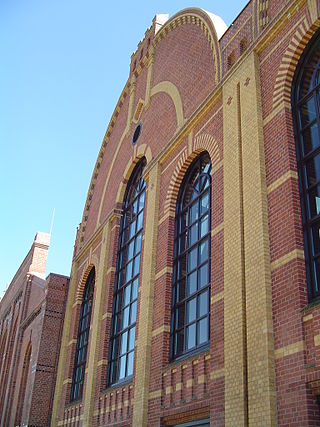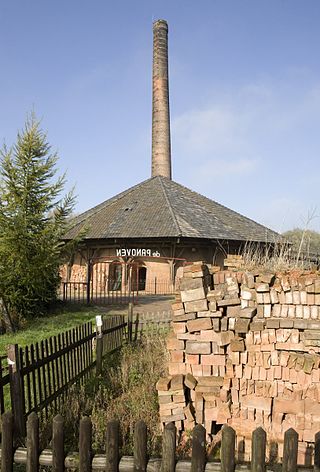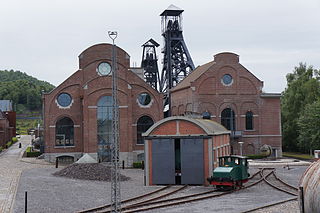
National Coal Mining Museum for England is based at the site of Caphouse Colliery in Overton, Wakefield, West Yorkshire, England. It opened in 1988 as the Yorkshire Mining Museum and was granted national status in 1995.

The Norwegian Museum of Science and Technology is located in Oslo, Norway. The museum is an anchor point on the European Route of Industrial Heritage.

Industrial heritage refers to the physical remains of the history of technology and industry, such as manufacturing and mining sites, as well as power and transportation infrastructure. Another definition expands this scope so that the term also covers places used for social activities related to industry such as housing, museums, education or religious worship, among other structures with values from a variety of fields in order to highlight the interdisciplinary character of industrial heritage. It is also argued that it includes the so-called sociofacts or aspects of social and institutional organizations, and mentifacts that constitute the attitudinal characteristics and value systems industrial heritage sites.

The Heineken Experience, located in Amsterdam, is a historic brewery and corporate visitor center for the internationally distributed Dutch pilsner, Heineken beer.

The Mueller Cloth Mill, located in Euskirchen, North Rhine-Westphalia, Germany is a section of the LVR Museum of Industry. The museum provides insight into the production process of a cloth mill by showing fully working machinery and equipment from around 1900. Opened in 2000, the museum preserves the mill's state at its shutdown in 1961. LVR Industrial Museum Mueller Cloth Mill is an ‘Anchor Point’ of the European Route of Industrial Heritage and a central stop on the ‘Wool Route’.

The Peenemünde Historical Technical Museum, former "Peenemünde Information Centre for History and Technology", is a museum, founded in 1991, in the observation bunker and site of the former power station in Peenemünde on the island of Usedom in eastern Mecklenburg-Vorpommern in Germany. The museum is dedicated to the history of the Peenemünde Army Research Centre and the Luftwaffe test site of "Peenemünde-West", especially the rockets and missiles developed there between 1936 and 1945. Since January 2007 the information centre has become an anchor point on the European Route of Industrial Heritage (ERIH), a Europe-wide network of industrial monuments, and a part of the ERIH themed routes for Energy and Transport & Communication.

The Saxon Museum of Industry is a museum with four locations in Saxony. It is organised as a "special purpose association", the members of which are the towns of Chemnitz, Crimmitschau, Ehrenfriedersdorf and Hoyerswerda.

The Augsburg textile and industry museum, known by its acronym tim, is a museum in Augsburg a city in the south-west of Bavaria, Germany. It is situated in the Augsburger Kammgarnspinnerei, a former worsted spinning mill. The museum is an Anchor point on the European Route of Industrial Heritage.

The Bocholt textile museum is a museum in Bocholt, a city in the north-west of North Rhine-Westphalia, Germany, part of the district Borken. It is situated 4 km south of the border with the Netherlands. The museum opened in 1989 as one of the eight locations of the LWL Industrial Museum: it is an Anchor point on the European Route of Industrial Heritage.

De Museumfabriek is a museum in Enschede, Netherlands. The new museum is located partly in a renovated Jannink textile factory, in reference to Enschede's textile history, and partly in an adjourning new building designed by the Amsterdam-based firm SeARCH. The project architect was Bjarne Mastenbroek. It is an Anchor point on the European Route of Industrial Heritage.

The Cité de la Dentelle et de la Mode is a museum of lace in Pas de Calais in northern France. It is one of two museums in France to celebrate machine lace making. The museum is an Anchor point on the European Route of Industrial Heritage. Cité de la Dentelle et de la Mode is a museum of both fashion and industry, its vast galleries present the techniques, the lingerie, and haute couture associated with this prestigious textile, as well as its most contemporary aspects. Derived from a technique invented in England in the nineteenth century, today lace woven on Leavers looms is primarily produced in Northern France. The Museum for Lace and Fashion is a focal hub for fashion. In its exhibition gallery, it showcases great couturiers and renowned young designers alike
The Espace Métal is a museum located in the ancient Charcoal Hall at Grossouvre, near to St Amand Monrond in the Cher department in the Centre-Val de Loire region of France. The museum is an Anchor point on the European Route of Industrial Heritage.

The Tyskie Brewing Museum or Tyskie Browarium is a museum in Tychy in Silesia, Poland. It was established in 2004. The museum is an Anchor point on the European Route of Industrial Heritage. It is an object of cultural heritage in Silesia (259/10), and a Polish national monument (641660).

The Historic Silver Mine is a UNESCO World Heritage Site in Tarnowskie Góry, Silesia, Poland. The mine and the neighbouring Black Trout Adit are remnants of a silver mining industry. The museum is an Anchor point on the European Route of Industrial Heritage. It also joined The International Committee for the Conservation of the Industrial Heritage and the Silesian Tourist Organization.

The Michal Mine is a former coal mine and now a museum in Ostrava in the Czech Republic.

Blegny-Mine was a coal mine in Trembleur, near Liège, in Belgium which today is preserved as an industrial heritage site and show mine. The museum features on the European Route of Industrial Heritage and is one of the four historical mines in Wallonia listed by UNESCO as a World Heritage Site in 2012.

The Brick Works De Panoven is a brick museum in Zevenaar, the Gelderland, the Netherlands. The museum is an Anchor point on the European Route of Industrial Heritage. It is also a rijksmonument.

The Bois du Cazier was a coal mine in what was then the town of Marcinelle, near Charleroi, in Belgium which today is preserved as an industrial heritage site. It is best known as the location of a major mining disaster that took place on August 8, 1956 in which 262 men, including a large number of Italian labourers, were killed. Aside from memorials to the disaster, the site features a small woodland park, preserved headframes and buildings, as well as an Industrial Museum and Glass Museum. The museum features on the European Route of Industrial Heritage and is one of the four Walloon mining sites listed by UNESCO as a World Heritage Site in 2012.

The Medemblik steam museum or officially the Netherlands Steam Engine Museum is a historical and science museum in Medemblik, North Holland, the Netherlands. Since 1985 the museum is located in a former pumping station, which was built in 1869 and decommissioned in 1979. The pumping station's installations are mostly still present and partly functioning. The museum is an anchor point on the European Route of Industrial Heritage, and the building and parts its interior are registered as a Rijksmonument, a national heritage site.

The Limburg Museum is a cultural-historical museum in the Julianapark in the Dutch city of Venlo. The Limburg Museum, the Discovery Center Continium in Kerkrade and the Bonnefantenmuseum in Maastricht are the three provincial museums in Limburg.




















